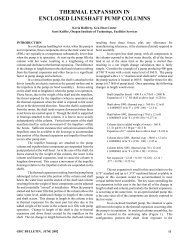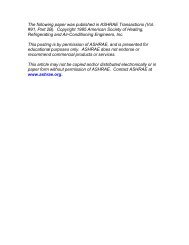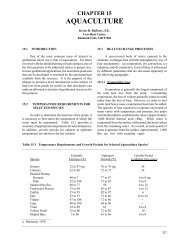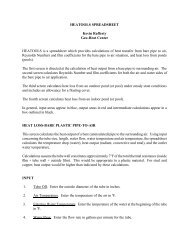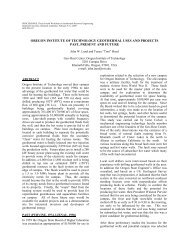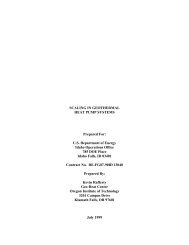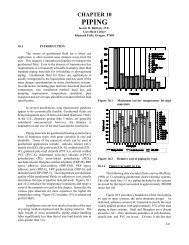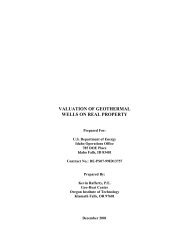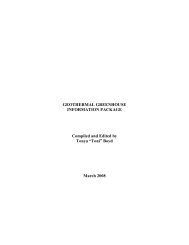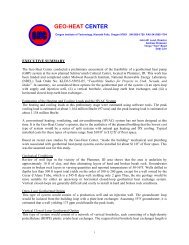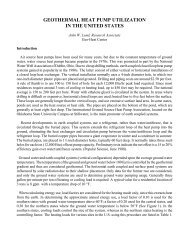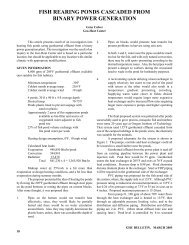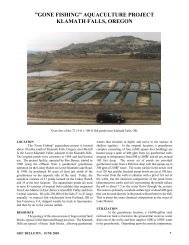Companion Study Guide on Short Course on Geothermal ... - OSTI
Companion Study Guide on Short Course on Geothermal ... - OSTI
Companion Study Guide on Short Course on Geothermal ... - OSTI
You also want an ePaper? Increase the reach of your titles
YUMPU automatically turns print PDFs into web optimized ePapers that Google loves.
corrosi<strong>on</strong> resistance, is ruptured in local areas and/or in crevices. These ruptured area then corrode<br />
in the form of pitting and crevice corrosi<strong>on</strong>. Figure 1 shows the relati<strong>on</strong>ship between temperature,<br />
chloride, and occurrence of localized corrosi<strong>on</strong> of Type 304 and Type 316. For example, this figure<br />
indicates that localized corrosi<strong>on</strong> of Type 304 may occur in 80 o F geofluid if the chloride level exceeds<br />
around 210 ppm; while, Type 316 is resistant at that temperature until the chloride level reaches about<br />
510 ppm. Type 316, as shown in Figure 1, is always more resistant to chlorides than is Type 304,<br />
due to its 2 - 3 percent molybdenum (Mo) c<strong>on</strong>tent. The fact that localized corrosi<strong>on</strong> can occur does<br />
not predict the rate, but <strong>on</strong>e should expect more severe attack as the chloride-temperature c<strong>on</strong>diti<strong>on</strong>s<br />
intrude further and further into the localized corrosi<strong>on</strong> regi<strong>on</strong>. These alloys can be used in this regi<strong>on</strong>,<br />
provided that oxygen is rigorously excluded, but there would be a risk of rapid failure should even<br />
traces of oxygen intrude.<br />
These alloys can also fail by stress corrosi<strong>on</strong> cracking above about 140 o F. In practice,<br />
however, no such failures have, to Radian’s knowledge, occurred in low-temperature (120 - 220 o F)<br />
geothermal applicati<strong>on</strong>s. As a precauti<strong>on</strong>, heat exchanger plates should be stress relieved after<br />
forming.<br />
Other austenitic stainless steels with increased chromium and molybdenum c<strong>on</strong>tents,<br />
compared to Type 316, can be expected to be resistant to pitting, crevice corrosi<strong>on</strong>, and stress<br />
corrosi<strong>on</strong> cracking under virtually any c<strong>on</strong>diti<strong>on</strong>s encountered with resources of this fluid class, but<br />
are not routinely available as HX plates.<br />
N<strong>on</strong>-austenitic stainless steels are generally resistant to chloride stress corrosi<strong>on</strong> cracking.<br />
But many, especially grades c<strong>on</strong>taining about 12 percent chromium and less than two percent<br />
molybdenum, will probably pit severely, especially in aerated envir<strong>on</strong>ments. More highly alloyed<br />
“super ferritics” offer c<strong>on</strong>siderable promise but have not been tested in these envir<strong>on</strong>ments. Type 444<br />
(18Cr-2Mo) has pitting resistance similar to Type 316. SeaCure (26Cr-3Mo), Allegheny-Ludium 29-<br />
4 (29Cr-4Mo) and Allegheny-Ludium 29-4-2 (29Cr-4Mo-2Ni) should resist any envir<strong>on</strong>ment<br />
resulting from use of fluids of this class. ASTM XM27 (26Cr-1Mo) is of intermediate resistance.<br />
All these alloys resist chloride stress corrosi<strong>on</strong> cracking.<br />
Aluminum<br />
<strong>Geothermal</strong> experience to date indicates that aluminum alloys will not be acceptable in most<br />
cases because of catastrophic pitting.<br />
Titanium<br />
This material has extremely good corrosi<strong>on</strong> resistance and should serve as heat exchanger<br />
plates in any low-temperature geothermal fluid, regardless of dissolved oxygen c<strong>on</strong>tent. Great care<br />
is required if acid cleaning is to be performed. The vendor’s instructi<strong>on</strong>s must be adhered to. In<br />
additi<strong>on</strong>, care must be taken to avoid scratching the titanium with ir<strong>on</strong> or steel tools, since this can<br />
cause pitting.



